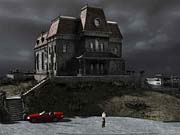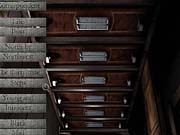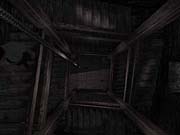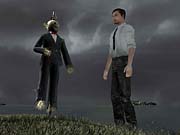With the exception of some extraneous elements, Hitchcock: The Final Cut doesn't have much to do with the master of suspense. It references his work, but it doesn't resemble it in tone or style. Some of the visuals are inspired by scenes from his films, one of the characters is a Hitchcock fan, and a few of the puzzles require a cursory knowledge of his more famous films--but beyond these superficial elements, the game bears no comparison to Hitchcock's world of paranoia, intrigue, and ugly deeds.

Joseph Shamsley is a private detective with psychic powers. According to the game's Web site, his parents died on the day of Alfred Hitchcock's funeral. Shamsley has been hired to investigate a series of disappearances on a movie set, a vanity project undertaken by an eccentric, wealthy Hitchcock enthusiast named Robert Marvin-Jordan. Early on, it becomes clear that the disappearances are actually murders and that there's something more complicated afoot than a film shoot.
So complicated, in fact, that it's nonsensical. Either The Final Cut features the most intricate web of false leads ever devised or the game makes no sense. It's impossible to discuss the problems of the story without spoiling some of it, although it's difficult to spoil something that's so incoherent. There may or may not have been a real film shoot. Everyone involved is working under an assumed identity, and none of them actually have any film skills. Is it an elaborate plot to set up Shamsley? Or a series of unbelievable coincidences? You'll never know, even if you finish the game. The Final Cut's plot has a few interesting threads, but none of it makes any sense when taken as a whole. You have a mysterious, mute niece with a precocious Minah bird named Alfred. You have a strange family with a dark past. You have a series of brutal murders that are all related but may or may not have been committed by the same person. The game never answers any of the questions it raises--instead, it shirks responsibility at the last minute by throwing some truly ridiculous curveballs your way.
It's disappointing, because the interesting elements of the story could have made for a decent game had they been flushed out, instead of simply thrown in the mix with all the other confounding stories. At the beginning, you start to connect the dots, and the plot seems to be heading in a good direction. But more and more facts and twists get added, and the dots just form a messy blob. The most interesting subplot bears more than a passing resemblance to Vertigo. It involves a dead woman who isn't dead and ends with a confrontation in a bell tower. The Final Cut is at its best when the designers just rip plot elements straight from Hitchcock.

Other references to Hitchcock include the manor where the Marvin-Jordans live, which looks like the Bates' house from the front, with a luxurious grand ballroom tacked onto the back. Having your home modeled after the infamous Psycho house, down to the tattered wooden floors, is a reason to question not just your sanity, but your taste as well. The other primary references to Hitchcock involve Shamsley's psychic ability, which gives him "flashes" when examining certain objects or places.
The psychic spells are all short clips from Hitchcock films, taken out of context and appropriated here as supposed insights into the story. Shamsley will see an overturned glass, and a quick scene will show a glass getting knocked over. He'll enter a bathroom, and you'll see a quick clip of the famous Psycho shower scene. Strangely, there's no attempt at making the contents of the game match the contents of the scene, so the bathroom in The Final Cut looks nothing like the bathroom in Psycho. Shamsley will examine a drinking glass, and the flash will show a coffee cup. It's as if the scenes were tacked on at the last minute, a suspicion that's all but confirmed by the fact that by the end of the game, the flashes have even less to do with the places or objects that inspire them.
The puzzles also occasionally reference Hitchcock's work. One requires you to put pieces of paper in order and complete film titles. Another requires you to position a compass. In case you can't get that one, there's a copy of North by Northwest sitting next to the compass. The puzzles are mostly easy, and even the easy ones are made easier. One puzzle requires you to put five colored make-up containers in a certain order. Sitting near the puzzle is a label that reads "Gorby." As if that weren't obvious enough, a colored dot appears under each letter.

Later in the game, you'll encounter a few Myst-like puzzles that seem completely out of place and are much harder than the earlier puzzles. And you also have your typical, completely illogical puzzles--for instance, Shamsley having to dress up as a dead woman to get information. Sure, it's a reference to Psycho, but it's also dumb. This puzzle is made worse by the fact that to imitate the woman's voice, Shamsley enlists the aid of the talking Minah bird. It may have just been easier to use the recording of the woman's voice that was sitting near the dress. And there is reportedly an action sequence in the game, though for some reason it ended automatically when we encountered it.
The vanishing action sequence isn't the only bug in the game, and most aren't as pleasant as that one. The game uses a sort of Alone in the Dark/Grim Fandango perspective, with you controlling the character from third-person with the arrow keys. The Final Cut features all the camera problems associated with that perspective and even adds a new one--occasionally, the view won't switch at all. You'll be looking at a skewed perspective of an office building, and Joe Shamsley will be long gone, offscreen, running in who-knows-what direction. Puzzles and close-ups switch to a different interface entirely, in which you use the mouse to interact. These views have bugs as well and occasionally won't let you exit back to the regular view at all.
There's no reason for the two control schemes. Even the more action-oriented parts of the game could have been easily accomplished with a standard mouse-driven interface, or the game could have opted for a keyboard-only interface, like Grim Fandango's. Instead, you get a sort of worst-of-both-worlds situation. Like other games that have used that visual style, The Final Cut uses 3D characters on 2D backgrounds. The game generally looks good, especially the dark and moody backgrounds.

Though the character voices are decent (despite the fact that the whiny, sarcastic voice of the protagonist in the opening movie is clearly a different voice from that of the much more competent voice actor heard throughout the rest of the game), the dialogue is terrible. The opening movie is so bad that it makes Max Payne look like The Long Goodbye. "Our cars mated," says Shamsley, describing a traffic accident. Other instances of terrible dialogue abound, and much of it seems like a bad translation. "For once, the audience won't be the one to undergo lobotomy," Shamsley wisecracks while examining the gory remains of a brained actor. He is insensitive, no doubt, and he can barely speak English.
Many years ago, the now-defunct Inscape released The Dark Eye, a similar game based on the works of Edgar Allan Poe. It didn't fare too well either, and it just goes to show that classic works don't necessarily make great games. It is notoriously difficult to create suspense in an adventure game. If you can't control the pacing, you get nothing but a bunch of illogical puzzles set to creepy music and cloudy skies. Fans of Hitchcock's work might enjoy the game simply for its "spot the reference" element, but the only suspense in The Final Cut is the fear that one of the numerous bugs will make it impossible to continue through the game's easy puzzles and nonsensical story.